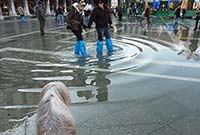Up and down with the tide

From October through early spring (and sometimes earlier or later), storm tides called "acqua alta" ("high water") flood low-lying parts of the city for several hours at a time.
What to expect:
| Level of tide: | Percentage of city affected: |
| Up to 80 cm | Normal tide |
| 100 cm | 4% |
| 110 cm | 12% |
| 120 cm | 35% |
| 130 cm | 70% |
| 140 cm | 90% |
As you can see, it takes an unusually high acqua alta to flood
more than a small portion of the city.
Unfortunately, some of the most popular areas of Venice (such as Piazza San Marco and the area around the Rialto Bridge) are also the most prone to flooding.
When acqua alta occurs:
- City workers set out passerelle (temporary elevated walkways) in the busier waterlogged streets and squares.
- Locals put on their rubber rain boots.
- Tourists borrow boots from their hotel concierges, buy disposable plastic boots from street vendors, wrap garbage bags around their legs, or roll up their trousers and wade barefoot.
- In extreme conditions, engineers deploy the new MOSE tidal barriers, which block unusually high tides from entering the Venetian Lagoon and flooding the city center.
How to prepare:
- During acqua alta season, check tidal forecasts before leaving your hotel. (See "Acqua alta warnings" below.)
- If you have room in your suitcase for waterproof boots, pack a pair.
Acqua alta warnings:
- Listen for the city's warning sirens, which sound whenever a tide of 110 cm or higher is expected.
- Install the hi!tide Venice app (iOS and Android) on your smartphone or tablet.
- Check the Italian-language official tidal forecast on the Web.
